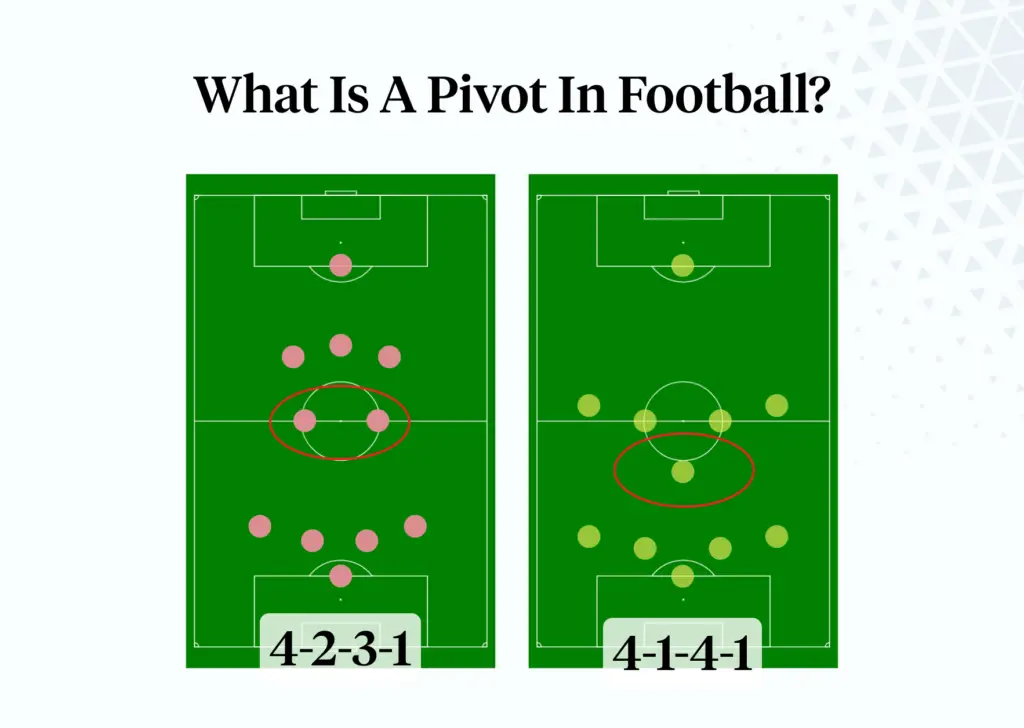Last updated on March 7th, 2022
Football analysts, pundits, and coaches have all debated the role of a pivot in football in recent years. This has often raised the question of what a pivot is among fans.
Here’s a guide that explains the meaning of “pivot” in football and the role performed by a pivot.
Contents
What is a pivot in football?
In pure football terms, a pivot is a midfield component that dictates how the rest of the team functions. There are different classes of pivots in modern football: a single pivot or a double pivot.
Essentially, a pivot is always located at the base of the midfield. It is said that this role came to be after the evolution of the sweeper role due to the shift to a four-man defence.
A pivot is the defensive midfield player who acts as the link between the defence and the rest of the team. The primary function of a pivot is to control and dictate the tempo of a game to suit his team’s style. Managers use a pivot to make things tick for the team by helping them control the ball and kick-starting offensive plays.
The midfield is arguably the most critical region on the pitch where a huge chunk of games is won. Consequently, managers tend to give special attention to their midfield combinations, which gives rise to the different pivot variations.
Some managers attempt to overwhelm their opponents by sheer force of numbers. They pack their midfield and hope to utilise the numerical advantage in their favour. Others use specialists in their pivot to give them an edge in midfield.
What is the role of a pivot on the pitch?
A pivot has different roles to perform on the pitch. However, a pivot’s primary function is to provide cover and screen his defence, preventing oppositions from breaking their lines. He also dictates the play with his passing and pass selection. The roles of the pivot differ slightly based on the type of pivot employed by the coach and the specific instructions they receive.
In a single pivot, only one player is left at the base of the midfield. This player is expected not to drift too wide in either direction to ensure he does not leave his central defenders without cover. The single pivot is seen in the following formations:
- 4-3-3
- 4-1-4-1
In his time at Napoli, Italian manager Maurizio Sarri managed to get the best out of midfielder Jorginho in this role. In Italy, the role is known as the “regista” role.
The regista is a lone pivot that directs and dictates play. Statistically, the regista is also expected to have a good number of interceptions, tackles and ball recoveries.
This is in addition to the expectation that they have excellent passing stats to control possession adequately.
Some other managers, such as Pep Guardiola, have different roles they expect their pivot to perform. Since his days as the manager of FC Barcelona, Guardiola has favoured the single pivot.
Presently at Manchester City, he uses Rodri in the role. He expects his pivot to influence the game without even touching the ball, as many other modern-day pivots do. Sergio Busquets is adept at this role and has been one of the world’s best in the position since making his debut under Guardiola.
In the same vein, John Obi Mikel used to play the pivot role under his managers when he was at Chelsea. His job was not to distribute passes or attempt skilful manoeuvres, but mainly to keep the ball moving.
In the 2012 UEFA Champions League final between Chelsea and Bayern Munich, the Nigerian was at his best when he had to shield two half-fit central defenders for 120 minutes.
The game showed another method a manager can use the pivot role.
What is a double pivot in football?
Unlike the single pivot, the double pivot usually comprises two players with different characteristics. They are expected to maintain a set distance between them at all times so as not to leave any part of their defence exposed.
Managers use the double-pivot to serve as a safety net for the back four at all times. To do this, they have to remain switched on at all times and be able to break up opposition counterattacks.
The defenders have different roles, such as being a centre back or a full-back.
The double-pivot acts as an insurance policy to give a team’s attacking players freedom to express themselves without too much caution or defensive burdens. Teams that are set up to play in the 4-2-3-1 and 3-4-3 formations usually use the double-pivot for sitting at the base of the midfield.
The double-pivot can have several different roles depending on managers and tactics.
For instance, Jose Mourinho led Chelsea to the English Premier League title in 2014/15 with an orthodox double pivot in midfield. The tactician used Nemanja Matic alongside Cesc Fabregas as his double pivot.
The arrangement was for one of them (Matic) to always hold his position while the other (Fabregas) was free to roam within a confined region.
This allowed Fabregas to use his brilliant creative skills to create chances and register assists for the forwards.
Another Chelsea manager, Antonio Conte, led essentially the same side to the Premier League title in the 2016/2017 season. The only tweak to his own double pivot was pairing N’Golo Kante with Matic.
This allowed him to get the best out of Kante, who could cover much ground due to having great fitness, while Matic stayed put.
To Conte, the creativity provided by Fabregas was not as crucial as the assured movements Kante makes in dealing with the opposition counterattacks. This gave the side a great deal of defensive solidity.
Who are the best pivots in football?
Here are the best examples of players who have managed to excel in the pivot role in each system:
Single Pivot
Sergio Busquets
Spanish midfielder Sergio Busquets has been the mainstay pivot for FC Barcelona for more than a decade. However, he can feature as a single pivot and double pivot, as he showed in the 2010 FIFA World Cup, helping Spain to victory.
He was paired with Xabi Alonso as his skill set allowed him to be efficient both in defence and offence. In addition, Busquets is excellent in reading the game, and this quality helps him thrive as both a single pivot and a double pivot.
Andre Pirlo
Former Juventus manager Andrea Pirlo first made his name as a player in his native Italy. The midfielder was perfect in the “regista” role for Juventus, AC Milan and the Italian national team.
His ability to spring attacks with his pinpoint passing from deep made him a huge asset for any team in midfield.
Jorginho
Chelsea midfielder and 2021 UEFA Player of the Year, Jorginho, is one of the world’s best in the single-pivot role. The Italian is brilliant in reading the game, allowing him to take up positions to recover the ball and remain calm in possession.
Jorginho is considered to be one of the best CDMs, and you can view how a CDM differs from a CAM here.
Double Pivot
Here are some examples of notable double pivots:
Joshua Kimmich and Leon Goretzka
Bayern Munich manager Julian Nagelsmann has used the German duo of Kimmich and Goretzka in a double-pivot role since his appointment as manager of the club.
Both players complement each other very well and have helped the side greatly in the 2021/22 season.
Thomas Partey and Granit Xhaka
Arsenal has thrived under Mikel Arteta in the 2021/22 season thanks to playing Partey and Xhaka in a double pivot role.
It has given the team a more stable spine, allowing more attacking-minded players like Martin Odegaard the room to thrive.
N’Golo Kante and Nemanja Matic
Chelsea secured the 2016/17 English Premier League title using this double pivot. Both players perfectly complemented each other, allowing Chelsea to dominate their opponents.
Can there be a triple pivot in football?
The triple pivot system exists in football, but it is not very common due to the system’s limitations to the team that uses it.
To play a triple pivot, a team requires three defensive midfielders. Teams generally do not start with a triple pivot system, but coaches may choose to shift the system to implement a tactical switch. Usually, when a team is trying to defend a lead, the manager can switch to a triple-pivot system to see an end to the game.
However, the triple pivot system is very flexible as it allows one or two of the members of the pivot to step up and join in the attack.
The triple pivot can overpower any opposition midfield because of its sheer number of players.
Jupp Heynckes used the triple pivot system to secure a place in the 2011/12 Champions League by finishing second in the 2010/11 Bundesliga. Heynckes deployed Michael Ballack, Arturo Vidal, and Simon Rolfes as the three holding midfielders to man the system.
In an orthodox 4-3-3, one midfielder plays as the pivot while the other two act as “mezzalas“, or wide central midfielders.
However, the formation can be modified to include a triple pivot by specific instructions from the manager who wants to achieve a more solid defensive display.
If the manager does not perform well, there may be a chance that he might get sacked!
Conclusion
Here is a summary of what a pivot does:
| Position | Midfield |
| Roles | Prevent opposition counterattacks Screen the defence Dictates play |
| Types | Single pivot Double pivot Triple pivot |
| Examples (Single Pivot) | Andrea Pirlo Sergio Busquets Jorginho |
| Examples (Double Pivot) | Joshua Kimmich – Leon Goretzka N’Golo Kante – Nemanja Matic Thomas Partey – Granit Xhaka |
A pivot has different roles, which will depend on how the manager wants to use them!
If you’re looking to buy the latest football merchandise from your favourite club, you can check out the latest deals at Kitbag.
Subscribe to Telegram and Twitter to get the latest updates!

Are you passionate about football and want to earn some side income?


